Chapter 18 - Rape and Sexual Assault
Rape is not the same as sex
Before we talk about these in detail, let’s define rape and call it what it is. Rape is violence, motivated by men with power, anger, selfishness, and sadistic issues. Rape is dangerous and destructive. Rape is not a laughing matter, not “a right of a male’s passage,” and is never not ever something a rape victim secretly wanted to have happen. Then what exactly is rape? Rape is violence. Rape is anger, hostility, abuse, bullying, “evil” pleasure-seeking (no matter the costs to the victim). If compared to racism the way Martin Luther King Jr describe racism, rape is “evil.” On the website maintained by The King Center, King’s philosophy of 3 evils and what to do about them is discussed in a very clear and understandable way:
“Racism – prejudice, apartheid, ethnic conflict, anti-Semitism, sexism, colonialism, homophobia, ageism, discrimination against disabled groups, stereotypes… “Racism is a philosophy based on a contempt for life. It is the arrogant assertion that one race is the center of value and object of devotion, before which other races must kneel in submission. It is the absurd dogma that one race is responsible for all the progress of history and alone can assure the progress of the future. Racism is total estrangement. It separates not only bodies, but minds and spirits. Inevitably it descends to inflicting spiritual and physical homicide upon the out-group.”(Quoted from “The King Philosophy Triple Evils”, Retrieved on 27 July 2020 from SOURCE)
After studying rape for over 30 years, after teaching students what they can do to prevent it, and after teaching students how they can help change the world they live in so it is less common and therefore safer for females and children (and others) where they live; I can tell you with confidence that rape has been perpetrated in many of the same way that racism was perpetrated (and still is), including by men and boys who are “prejudiced, politically justified in their own minds; fighting ethnic conflicts; anti-Semitic; sexist; colonialist; homophobic; ageist; biases against disabled, LGBTQ individuals, and others. I can also state with confidence that a rapist also: has a contempt for life; arrogantly asserts that only one person’s (his own) pleasure and choices matter and the victim’s do not; and is a “criminal” by every definition of criminal we use.
The rapist has to deal with his evil actions and often refuses to own up to them. He therefore blames the victim to justify his crime. He objectifies his victims (sees them as being less than human), so they are easier to hurt. And he inflicts social, emotional, intellectual, spiritual and physical “homicide” on whomever he selects to harm. Why use the pronoun “him” to describe a rapist? Most rapists are men or boys. Why define so definitively the rapist in such overwhelmingly final terms as these? A rapist earns these through his perpetrated (or acted out) violence. King stated that “Ultimately a great nation is a compassionate nation (ibid).” King’s non-violent principles to remove racism can be applied to making a society safe again for women, girls, and others. To me the difference in the discriminating racists and the violent rapist is very thin as far as the types of evil they perpetrate. The details of their actions may differ, but as King described a racist and racism; and Sociological and Criminal Justice research defines rapists and rapes, they are equally evil in how they disabuse another human being.
Why would a textbook like this one dedicate an entire chapter on understanding and helping to prevent rape? I want to answer that from an academic, larger social level, and personal point of view. From the academic point of view, we need to consider the motives of rapists which differ dramatically from most men’s motives. From the larger social level of the problem we need to look for larger social trends, including rates. And from the personal point of view we need to think about what we might do as individuals. Rape is a problem that, since the 1960s has increasingly gotten worse and worse. An act of sexual violence, including rape is destructive to the individual rape victim and the many friends and family within that victim’s primary and secondary groups.
I came across a United Nations article on 16 Ways we can stand against rape culture (see UN (18 Nov. 2019) “16 ways you can stand against rape culture” retrieved 27 July 2020 from SOURCE). When you read this online article you will see some well-supported known principles of helping to reduce rape and perhaps help to stop it altogether. Table 1 lists those 16 ways for you:
Table 1. List of 16 Ways you can stand against rape culture*
- Create a culture of enthusiastic consent.
- Speak out against the root causes
- Redefine masculinity
- Stop victim-blaming
- Have zero tolerance
- Broaden your understanding of rape culture
- Take an intersectional approach
- Know the history of rape culture
- Invest in women
- Listen to survivors
- Don’t laugh at rape
- Get involved
- End impunity
- Be an active bystander
- Educate the next generation
- Start—or join—the conversation
King’s principles apply to this United Nation’s list of strategies. King stated that nonviolence must: become a way of life for us; seek to win friendships and understanding; seek to defeat injustice and not people; believes that suffering can both educate and reform; chooses love instead of hate; and believes that the universe is on the side of love and not hate (see “SIX PRINCIPLES OF NONVIOLENCE” “The King Philosophy Triple Evils”, Retrieved on 28 July 2020 from https://thekingcenter.org/king-philosophy/ ). Combining the 16 UN Steps and Kings 4 principles, you can help to make the world safer for women, girls and others. You can use these at the personal level in daily interactions with your family and friends. You can use them in classrooms, at work, at parties, and in the community. You can join a cause that matches your values and give time, resources, and your ideas to help. You can stand up when you see danger of rape or sexual assault of any form. You can call for help, call police, use your cell phone and take footage, be willing to get involved, and not stand passively and let things happen. These 3 cases really occurred. They are examples of personal level options that can be considered now and can be a basis for giving you more information and hopefully more confidence to act.
Case of Student #1:
You can do what one of my students (I’ll call her “Deb”) did and reach out to a female student she was worried about a frat party. When Deb realized that this very young female student was under the influence of something she called the police from the bathroom and reported a “welfare check” for a drunk young woman who was being taken advantage of. The police came and met Deb. Their efforts led to discovering illegal drugs and 5 high school students (underage). They took the female student by ambulance because no one could get her awake enough to respond to questions.
Case of Student # 2
Another student (I’ll call her “Sam”), was walking to lunch and came across another female student crying and half collapsed against the wall. That student had just been sexually assaulted in the nearby stairwell. Sam alerted a professor who was walking by. They all three stepped into an academic office and shut the blinds. The secretary called campus police. Sam called the campus sexual assault hotline. The victim described the assailant, what he was wearing and they he had quickly ran into the men’s room. The professor went into the men’s room and saw someone pacing nervously behind a bathroom stall door that was slightly open and no other men were in that bathroom. The professor exited after slowly washing his hands (stalling for campus police to arrive) then exited and waited near the bathroom door waiting for either the police to arrive or the alleged perpetrator to exit. In the meantime, the professor asked a total of 6 others to wait with him and told them what happened and that he needed a crowd to form so when the guy came out they would all stare quietly at him, cell phones in hand.
Keep in mind that there was no plan, no training, and no prior experience for any of this professor and 6 others in their small crowd. When the alleged perpetrator glanced out of the door and saw the crowd he quickly retreated. Not a word was said by anyone. By the time the alleged perpetrator decided to leave, he walked directly into the campus police officer and the professor and students point him out immediately. The story doesn’t end there. Sam took the victim out the back exit door and headed for Student Counseling Services. The campus police spoke with her and then created a police line up in which the victim identified with absolutely undeniable detail why the young man in custody was her attacker. The police told the young man that he had been identified and he confessed. What none of the students, college staff, victim or professor knew is that this was the 4th attack on campus in 4 days! Had no one decided to do something, there could likely have been many more. All of them required courage with Martin Luther King Jr. said would come to those fighting “evil” in nonviolent ways. It doesn’t take more courage than most people have. It just takes enough to try and to get others to join your efforts. There is a 3rd case that I will present at the very end of the chapter. I have taught at 4 universities for about 33 years at this point in my career. I have read about and studied cases of members of the campus community who chose to get involved and how their efforts made a difference.
A Rape rate is defined as Rape Rate=number of rapes in a population in a given year per 100,000 females in the population during that same year (#of Rapes each Yearx/100,000 women living in society in Yearx). The United States ranked the 14th worst in 2019 with 13 other countries having worst rape rates than the U.S. as of the latest available information, the worst (most dangerous countries for rape) had a rape rate/100,000 of: South Africa (132.4); Botswana (92.9); Lesotho (82.7); Swaziland (77.5); Bermuda (67.3); and then Sweden (63.5). (see “Rape Statistics by Country 2020” retrieved 28 July 2020 from SOURCE). That means that in South Africa, 132.4/100,000 or about 13 out of every 100 women were raped in South Africa that year. The United States ranked 14th most dangerous for rape at 27.30/100,000.
Consecutive studies performed by the United Nations Surveys on crime Trends and the Operations of Criminal Justice Systems confirm that South Africa is the most dangerous, crime-ridden nation on the planet in all crimes including rape SOURCE.
Rape happens quite often in the United States and the US ranks among many other nations with its rape rate
The FBI typically keeps statistics on violent crimes committed and reported to local police (unreported crimes cannot be counted in the FBI Uniform Crime Reports). It summarizes all the local and state crimes into reports made available on various government Websites. From these data, the Bureau of Justice Statistics provides specific rape rates per 100,000 for the years 1960 to 2018 (See Figure 1 below). Alaska is by far the most dangerous state as far as rape rates are concerned and West Virginia is an example of one of the safest. The U.S., Alaska and West Virginia have seen a slight increase in rape rates. These rates tend to rise and fall over a period of a few years, but the rape rates have not yet returned to the 1960 lower levels. Why the U.S. and specifically why the state of Alaska is so high has been studied extensively. This is a complicated social process that is entangled in religious, political, and very intensive emotional efforts to analyze and understand. Think about explanations you have about why the rape rates are so high and as you read further below, consider some new ways of seeing this challenge from a Sociological point of view.
Figure 1: Reported Rapes per 100,000 Population in United States, Alaska (Worst State Rate), and West Virginia (Safest State Rate), Years 1960-2018*
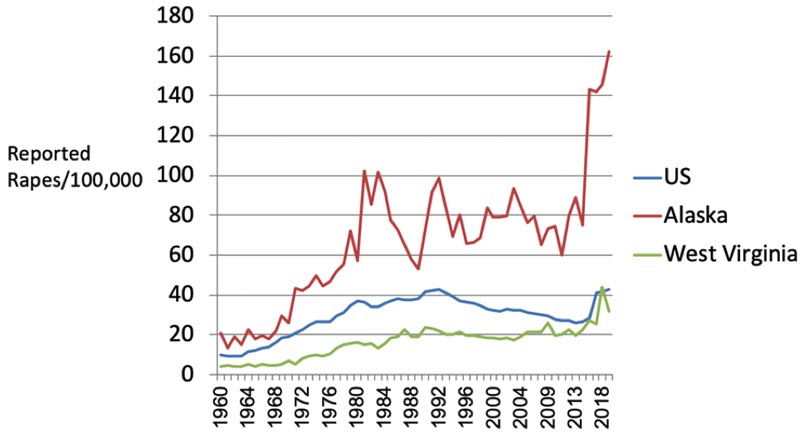
The National Sexual Violence Resource Center (NSVRC) is an organization which focusses on helping prevent sexual violence and helping members of society respond to sexual violence ( See their NSVRC About page at https://www.nsvrc.org/about/national-sexual-violence-resource-center ). Some of the data they report on includes the Bureau of Justice Statistics’ annual National Crime Victimization Surveys (NCVS). Remember back in Chapter 8 we talked about how the NCVS interviews random samples of people about crimes they have experienced in recent years and if they reported or did not report the crime to police. Based on that the NSVRC often reports the data from the NCVS that can be used to prevent and help respond to sexual violence. The NSVRC reported shocking data from the 2015 and 2018 NCVS data. Based on 2015 & 2018 NCVS data, NSVRC reported that:
“Approximately 1 in 5 (21.3% or an estimated 25.5 million) women in the U.S. reported completed or attempted rape at some point in their lifetime, including completed forced penetration, attempted forced penetration, or alcohol/drug facilitated completed penetration. About 2.6% of U.S. men (an estimated 2.8 million) experienced completed or attempted rape victimization in their lifetime.” “The self-reported incidence of rape or sexual assault more than doubled from 1.4 victimizations per 1,000 persons age 12 or older in 2017 to 2.7 in 2018. Based on data from the survey, it is estimated that 734,630 people were raped (threatened, attempted, or completed) in the United States in 2018. Despite the increase in self-reports of rape and sexual assault, there was a decrease in reporting to police from 2017 to 2018. Forty-percent (40%) of rapes and sexual assaults were reported to police in 2017, but only about 25% were reported to police in 2018.” (retrieved from the “Statistics” page on 28 July 2020 from SOURCE).
As you can see, many crime victims in the U.S. never report the crime. In Figure 2 this is very clearly shown for the years 2006-2015. Based on NCVS 2018 aggregated date, Figure 2 shows that 3 times as many sexual violence crimes occur for every sexually violence crime reported to police. Although it is far less common, men and boys can be sexually assaulted, and the attacker is most often male.
Figure 2. NCVS Factsheet Data Trends 2006-2015*
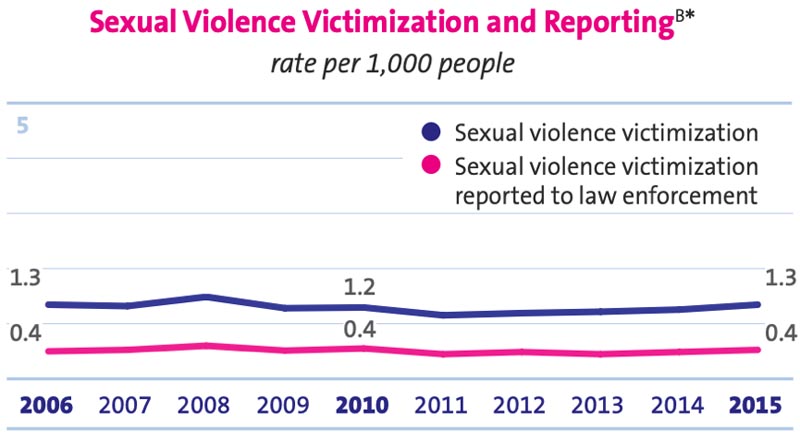
Figure 3 shows another disturbing graphic from the same 2018 NCVS Data pdf. For both men and women who are sexually assaulted, over half the men and 41 percent of the women knew the attacker. How could it be a “rape” if the victim knew their attacker? Rape is defined as “violence, motivated by men with power, anger, selfishness, and sadistic issues. Rape is dangerous and destructive.” It is not defined as being perpetrated by any type of known or unknown attacker. A female college student could meet her roommate’s friends, new acquaintance. Later, assuming her roommate is safe, her roommate’s’ friend is safe, she might also trust this distant acquaintance enough to open the door of her apartment and let him in. There alone a sexual assault could take place. Rape could be perpetrated by a brother, father, grandfather, other relative, club member, church member, etc. Be careful of the “But she knew him. How could that be rape?” myth.
Figure 3. Relationship of Sexual Assault Victim to the Perpetrator*
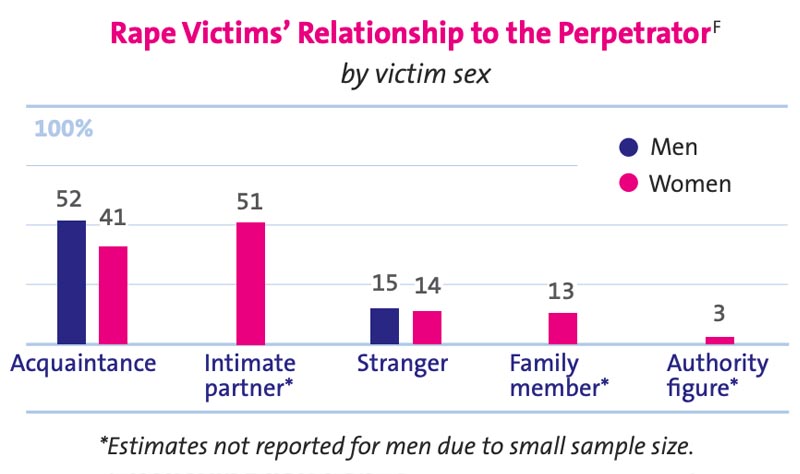
One final diagram from this report is also disturbing. Figure 4 shows that Rape and Sexual Assault are costly over the lifetime of the rape victim. The costs include “The estimated lifetime cost of rape was $122,461 per victim, or a population economic burden of nearly $3.1 trillion (2014 U.S. dollars) over victims’ lifetimes, based on data indicating >25 million U.S. adults have been raped. This estimate included $1.2 trillion (39% of total) in medical costs; $1.6 trillion (52%) in lost work productivity among victims and perpetrators; $234 billion (8%) in criminal justice activities; and $36 billion (1%) in other costs, including victim property loss or damage. Government sources pay an estimated $1 trillion (32%) of the lifetime economic burden.” (Cited from Lifetime Economic Burden of Rape Among U.S. Adults by Cora Peterson, PhD, Sarah DeGue, PhD, Curtis Florence, PhD, Colby N. , and Lokey, MS (January 30, 2017) in Am. J. of Preventative Medicine. DOI: https://doi.org/10.1016/j.amepre.2016.11.014 ).
Figure 4. The Lifetime Cost of Sexual Violence*
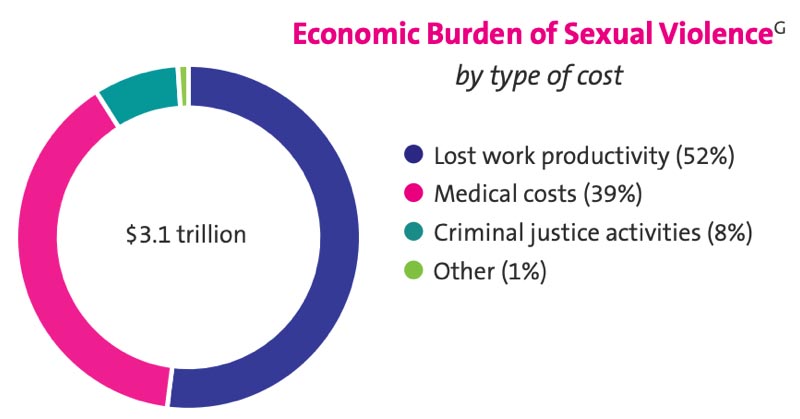
Figure 5 shows how the youngest aged adult females (ages 18-24) in U.S. society are consistently at highest risk for sexual assault crimes. The NCVS 2014 reported on rates of sexual assault among college-aged victims ages 18-24. The report stated that “From 1997 to 2013, females ages 18 to 24 consistently experienced higher rates of rape and sexual assault than females in other age brackets.” This report stated that among the college students, far more victims were female than male (83% Female and 17% male). Among the non-students the same pattern was found (96% female and 4% male). About 80 percent of female victims knew their attacker.
Figure 5. NCVS Results of Sexual Assaults to Students and Non-Students ages 18-24 from 1997-2013*
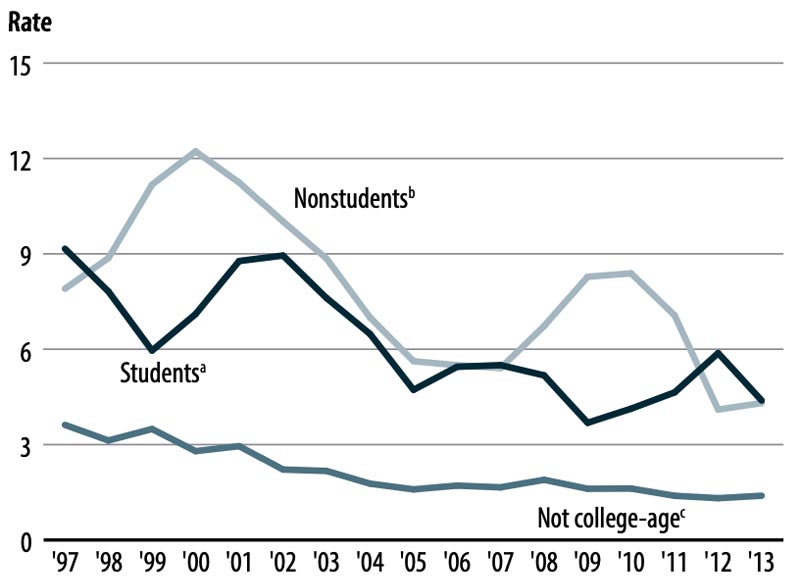
The Rape Abuse & Incest National Network, an online Web page and the largest US’s anti-sexual assault organization provides tremendous insight into rape. They also provide support for those impacted by rape (1-800-656-HOPE and an online hotline at http://www.rainn.org ). Their definition of rape and sexual assault reads: “The term "sexual violence" is an all-encompassing, non-legal term that refers to crimes like sexual assault, rape, and sexual abuse. Many of these crimes are described below. Please note that the legal definition of crimes vary from state to state…” RAINN.org then provide in depth definitions of “Sexual Assault; Child Sexual Abuse; Sexual Assault of Men and Boys; Intimate Partner Sexual Violence; Incest; and Drug-facilitated Sexual Assault ( see details at https://www.rainn.org/types-sexual-violence ). In general, state law assumes that a person does not consent to sexual activity if he or she is forced, threatened, unconscious, drugged, a minor, developmentally disabled, chronically mentally ill, or believe they are undergoing a medical procedure.

Perpetrators of sexual assault can be strangers, friends, acquaintances, or family members. Often, perpetrators commit sexual assault by way of violence, threats, coercion, manipulation, pressure, or tricks.
The Personal and Larger Social Levels of Rape’s Impact on Society
In this discussion we will use C. Wright Mills’ Sociological Imagination and study rape a bit more from both the from both the personal and larger sociological levels. Because of the way I context it here, this section may sound much like an advice column with specific suggestions and strategies for you to consider. Trust me, many research-based principles guide this discussion and you can place a high degree of confidence in these arguments.
The Personal Level: Whose Fault Is It?
The fault lies squarely on the rapist and his personal choices. Rape, by the definition given above is, not consensual. Many throughout the history of the world have defined rape as a form of sex. Look at this statement carefully:
Rape ≠ Sex
Rape has no consent. Sex has mutual consent. Typically, force or threats are used to coerce compliance. I often have students ask me, "what if she agrees at night, then changes her mind in the morning and says she was raped?" My response is that in this case mutual consent occurred and a lie was told afterward. I then ask the student why he or she asked this hypothetical question (I assume they have a hard time believing the victim’s claim). Often they’ve heard that "almost" all rape allegations are false.
How might you help a rape victim at the personal level, using the best research from decades of study in the U.S. larger social level?
So, what might you say if you hear from someone that they were raped? At the personal level, with your friends and family members who might or ever have been raped, there is one crucial question you must ask, "How are you doing now?" Whatever it takes, avoid the common mistake of asking, "What were you doing when this happened?" For many of us, we feel that our own safety is threatened when we ourselves know the victim and we often ask "what happened?" in an attempt to protect ourselves in the future. The point is to ask how a rape survivor is doing now, because it keeps them in the now. Their answer to how they are doing might provide insight into how you might be of support of them. The question of what happened puts them emotionally back in the time and place of the attack and reopens the wound again.
The Oil and Water Paradigm
I’ve taught a paradigm for years to my students which has helped them to distinguish the two core issues in the case of rape: first, we live in a dangerous world which requires women to be vigilant in defending and protecting themselves; and second, it is never the victim’s fault. I call this the "Oil and Water Paradigm." In Figures: 6, 7, and 8 below, you see two exclusive and unmixable sides of the same issue. Here’s the metaphor in a nutshell; no matter how hard you try, the fundamental structure of oil and water make them impossible to ever mix. Think of your bottle of Italian salad dressing. You shake it vigorously and have to quickly pour it on your salad before it separates again. Oil repels water. In this paradigm, I use oil and water as metaphors for understanding these ideas that should not be mixed (because they really don’t mix).
In Figure 6, you see the self-defense component of the dangerous society we live in today. Women have to protect themselves from attacks. True, most men would never attack a woman. But, women can’t discern which men are safe and which are not, simply because rapists are very predatory and deceptive. Don’t get me wrong women are quite capable of living under these dangerous circumstances, but morally shouldn’t have to. I heard a friend of mine say, "It’s just sad that one-half of the population (women) has to live in fear of the other half (men), because some of the other half might attack them." In the US, about 3 out of 4 rape victims knew their assailant before the attack.
Figure 6. The Oil Side of The Oil and Water Paradigm

If you don’t already know this, you will learn that women don’t need to be protected by men or by others. Women are not frail or week and vulnerable any more than men are. But, watch the news; read the research; study the recent and ongoing social trends of increasing violence in U.S. society. We all need to stand together and help one another and if needed protect one another (Men and Women). Remember there are about 180 countries safe to live in than the United States. Besides, all over the world and especially in the U.S., women spend time, money, resources, and emotional energy being vigilant against a potential attack. The burden of protection falls mostly on them and their close friends and family. My students carry their keys so they can use them as weapons, carry pepper mace, take Karate, travel only with friends at night, and some even have a safety plan for their apartment. But, you have to know, there is no single preventative measure that can universally prevent rape. I interviewed a former FBI profiler, Greg Cooper. When I interviewed him he indicated that the FBI puts all the blame for the rape on the perpetrator, not the victim.
Often times rape victims blame themselves, trying to figure out what exactly they did to cause the attack. From a law enforcement point of view, victims have no responsibility. There is nothing that the FBI can tell a woman to wear, to do, or to say that will decrease her likelihood of being attacked. The perpetrator bears all the blame and it’s him that we focus on.
Women know from their childhood that certain men can be dangerous and that they have to become diligent in protecting themselves. In Figure 7 you see the clear and simple truth that rape is never a victim’s fault (remember that sex has consent rape does not). There is not one case, ever, where a rape victim is at fault. I’ve heard many argue with me on that point. They say, "what if she dressed in sexy clothes, went into the bar looking for some action, invited him up to her place, agreed to go on the date…" This type of thinking seeks to shake the oil and water together by erasing that line that separates them (oil and water don’t mix, no matter how hard you shake the Italian dressing, it eventually separates back into oil and water). If we ask them to explain the details, then carelessly say something like, "why’d you go on a date with him anyway?" then we’ve just blamed the victim.
Figure 7. The Water Side of The Oil and Water Paradigm
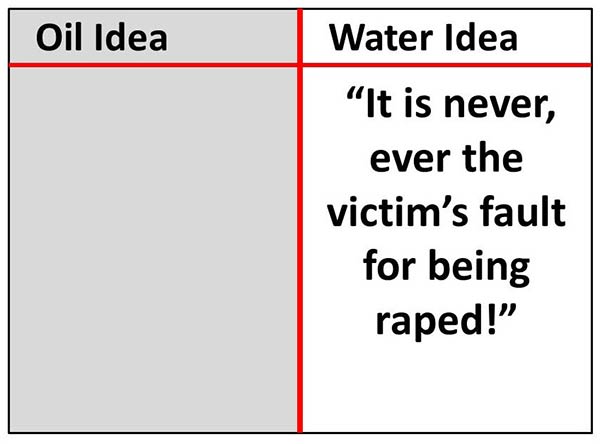
Figure 8 shows both the ideas in the same diagram. It’s like the woman standing on the sidewalk and a man drives up on the sidewalk and runs her over. And an eye witness rushes to her aid and says, "Why were you standing on that sidewalk when you knew a truck could run you over? Were you trying to get attacked…"
Figure 8. The Complete Oil and Water Paradigm
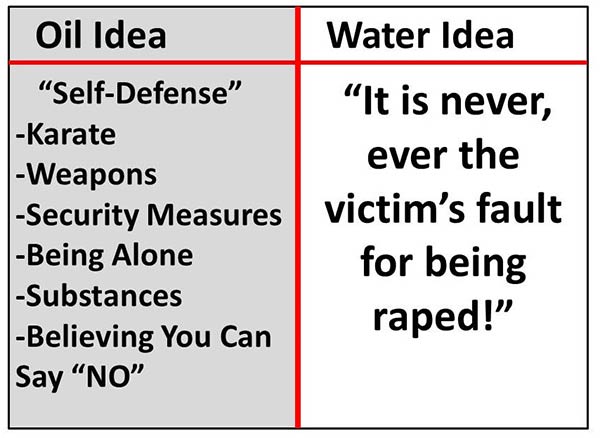
Think about what a rape victim has been through: bruises, cuts, gun & stab wounds, STDs, and pregnancies, internal injuries, chronic pain, persistent headaches, facial pain, sleep disorders, depression, PTSD, attachment problems, trust challenges, flashbacks, anxiety, panic attacks, and difficulty turning to closest support system (family, Friends, others). One rape survivor compared her attack to the September 11, 2001 terrorist attacks on the U.S. She explained that just like we often refer to the pre 9-11 era of this country, she refers to the pre-rape era of her life.
Not only do rapists hurt their victims, they often blame them verbally before they leave. This makes recovery even more difficult since most rape victims already blame themselves (see Ullman et al 2007 about the construct of self-blame and a model for assisting survivors in their recovery at SOURCE and in Murnen, et al. 1989 a study of college student established that most victims blamed themselves at SOURCE.
Yes, it is true that most victims erase the line and blame themselves. "I should have…" is the most common lamentation. Hind sight gets confounded by grief and recovery. Yet, the last thing a rape victim needs is for you or anyone else in their support network to add to that grief by adding your intentional or unintentional blame. Keep oil and water apart. Defense attorneys often blame victims in the courtroom, media reports often imply or convey to blame to victims; and since rape victim’s family and friends grieve too, they often blame self and the victims. You wouldn’t slap a mugging victim for walking down the street alone. They’ve already been through enough. But sometimes we believe that only good things happen to good people (Google "Just World Syndrome" for more insight to this myth). Violence happens to both morally good and bad people. It always has.
Helping Survivors To Avoid Blaming Themselves
Consider the comments made by two rape victims I personally interviewed (their names have been changed to protect their privacy). Nella had been raped in Colorado five years prior to our interview. The rapist trapped her and assaulted her over the course of three hours. Nella escaped and ran to get help from a friend. They called the police. The police put out an APB on the assailant’s car and arrested him within the hour while he casually shopped for groceries in the local supermarket.
Nella told me that during the trial her attacker and his attorney turned the entire attack back against her. "I sat stunned on the witness stand," Nella explained. "trying to figure out why I had to defend myself when I was the one who was so brutally attacked." "I feel peace right now, but I live in constant fear that when he gets out, he’ll somehow find me. Anyway, he threatened my life while he attacked me, saying if I went to police he’d find me and kill me." Nella explained through tear filled eyes. "I went to police anyway." Nella, like many other rape victims was emotionally victimized again during the trial. Nella’s attacker was sent to prison and is already out on parole.
Jana’s assailant was a coworker. He asked her out to dinner and attacked her in a secluded area near the restaurant. Afterwards, he showed no remorse, no guilt, not even an acknowledgment that he’d just done something terrible to her.
"He was such a nice man to me until we were alone." Jana reported. "Then his countenance change. I saw evil in his eyes, but couldn’t get away because he had planned the entire thing in advance." Jana shook her head as she gently held the locket hanging on the chain around her neck. "This is a picture of my son." She opened the locket. "He was the only good thing that came from the whole experience."
Jana reported the rape to police. The rapist served time in jail and was under suspicion for other rapes in the area but nothing ever came of that. The rapist is out of prison now. Jana moved and tries to move on with her life; much like the countless other survivors throughout the state and country are forced to do.
In summary, on the personal level you can be a great asset to a survivor of rape. You might find yourself someday on a jury where other jurors blame her for not protecting herself. Remember what the core message portrayed in Figure 9 is claiming: “Rape has no consent and is never the victim’s fault, even if women live in such a violent society that they constantly have to be on vigil to protect themselves from violence.”Don’t mix those 2 “unmixable” ideas because the rape victim will be the one who suffers from doing that.
Figure 9. Don't Mix the Oil and Water
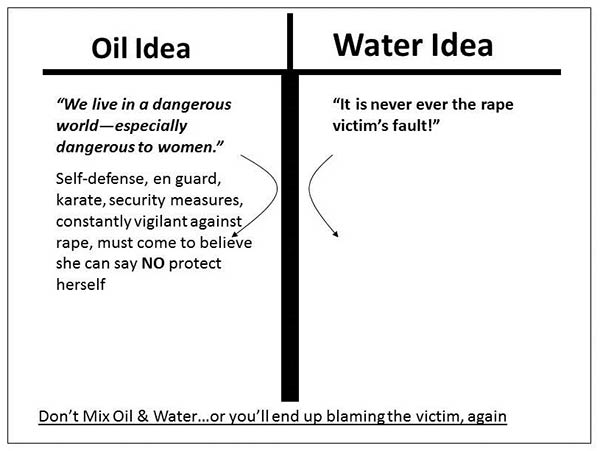
Larger Social Explanations
At the larger social level rape can be understood through scientific studies, analysis of crime data, and interviews with rapists. We can understand trends about rapists and why they do what they do. We can also understand national social facts that can indicate how best to handle the problem from every level of social intervention. What are some of the possible explanations for high rape rates in the United States? A few trends emerge from my 3+ decades of research:
- An increase in rape prevention programs and rape crisis centers so that, unlike in the past, where a rape victim had a very difficult time in reporting rape, we now have a structure in place where victims can go for assistance. This may indicate that rape happened more in the past, but was reported less because of the absence of a legitimate place to go report it and get help.
- An increase in substance use among perpetrators and victims which is highly correlated with decreased inhibitions by men who might not otherwise act violently toward women.
- 1960s, 1970’s, and 1980’s shift from abstinence to sexual promiscuity where men are more likely to feel entitled to whatever sexual desire they have. This may have also coincided with male value shifts in expectations of self, women, and sexual predation (see Figure 10 below).
Figure 10: Value Shift Among Males Over the Last 35 Years

Many men in our day have abdicated the protector, nurturer, and community-minded roles common among men in the past. Rapists have specifically become scam artists where the confidence scam of establishing trust among women then violating that trust has become all too common. Many rapists report feeling victimized when they are arrested and held accountable (over 6 out of 10 US rapist are not held accountable in terms of prison or guilty verdicts).
Rapists are the core of the problem. Look at Figure 12 below. Rapists act worse than evil racists. They act in anti-social, violent, and aloof ways that ignore all consequence to the victim of their violent actions. Rapists deny any harm, are dangerous to themselves and society; disrupt life and society, and self-individualism focused rather than focused on themselves and the larger community they belong to in a society. For all the men reading this book, don’t feel misplaced shame, blame, or guilt. Most of the men in this society do not rape or commit other forms of sexual violence (only a few do and will). They don’t feel shame or guilt. Most studies show that they feel entitled to do whatever they want. Simply put, if you do not commit sexual violence against other individuals, this is a foundation of knowledge that can empower you and everyone else in society to reduce, prevent, and someday eliminate any rape from all societies.
Figure 12. The Core of the Problem=Rapists
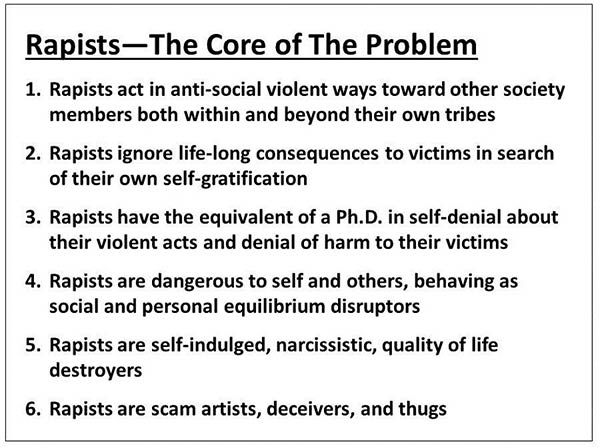
As mentioned before, I interviewed Greg M. Cooper, a former FBI profiler. To the FBI, rape is not about sex. It is about power, domination, anger, and the ability to control and destroy another person’s life. A rapist expresses his need for power, domination, and anger in a sexual way. I must say this confuses many students. They ask, "how can rape not be sexual if the vagina and penis and other sexual parts of the body are involved?" My answer follows the statement made by a nun who was teaching a group of survivors.
"A man can use his hand with a number of different motivations. He could caress the hair of his loved one, massage a back, or simply hold another-motivated by love and concern. He could also strangle, beat, and otherwise inflict pain upon another. It’s not that the hand is a body part exclusively designed for nurturance or violence—it’s the motivation behind how the hand is used that makes the hand what it is."
The same can be said about our body’s sexual parts. In a mutually consenting relationship between people of legal age of consent, sexual parts of the body can be used out of a motivation of intimacy. For rapists the sexual parts are used out of power, domination, anger, and control. The FBI and researchers in the field of Criminal Justice know that anger, power, sadism, and even sexual gratification is what motivates rapist to attack (see Wikipedia page at SOURCE).
Greg Cooper utilized a model with four types of rapists based on their risk of harm to the victim and their level of confidence in their violence. Power-Reassurance Rapists are the most common type of rapist; he uses little to no violence; has a very weak sense of self and of lacking "manliness;" and rape is his outlet of power, domination, anger, and control (see Figure 132). This rapist is inadequate in general and rapes in a futile attempt to feel adequate. The Power-Assertive Rapist has a very low self-concept; he attempts to reassure himself of his manhood; and uses very little force or violence. His deep-seated shame drives him to offend often and not feel long-term satisfaction from the assaults.
Figure 13. Four Types of Rapists
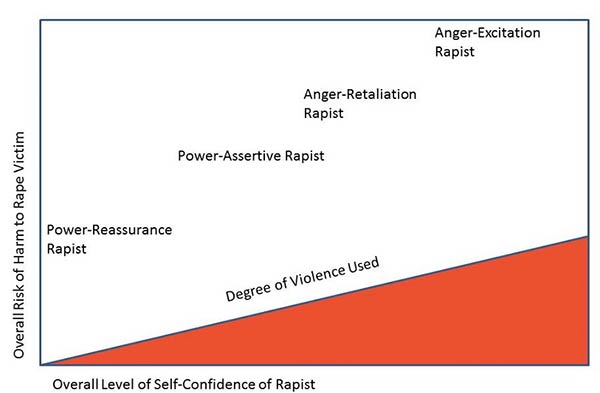
The next two types of rapists are more dangerous. They tend to have a better self-image and will use violence. The Anger-Retaliatory Rapist has plenty of self-confidence (perhaps to the point of too much); he tends to demean, degrade, humiliate, and punish his victim for things she did not do (for example his bad day at work might be taken out on her); and he tends to be brutal, blitzing his victims so that they offer little resistance. This rapist is making the victim pay for things gone badly in his own life.
The Anger-Excitation Rapist is the least common type, yet the most evil; he will torture, kidnap, and even kill his victim out of pleasure-seeking at the cost of another’s pain; he is sadistic and predatory; and he uses his intelligence to plot and prey upon unsuspecting victims. Greg Cooper also referred to him as "evil" and "the dark side of humanity."
How can a man ascribe to such low values toward another individual? I borrow my answer from a Ugandan born man who lived in South Africa for a decade (I will call him Masoud). Masoud said, in our interview about the enormously high rape rates in South Africa, that:
"Real men don’t rape. Raping is really against the character of a good man and all that is necessary for good behavior in a civilized world."
Perhaps this will be the legacy of U.S. society 2020 and beyond, where social reform programs focus on efforts to transform values of men toward a more respectful view of women. One hopes that some of society’s potential rapists get exposure to such a program, experience a shift in values toward respecting women, and ultimately lower the incidence of rape in the United States and the rest of the world.
The FBI tabulated Uniform Crime Report (UCR) data from police agencies around the U.S. Using 2018 data such as these, the FBI also produces an annual Crime Clock (see Figure 14) which provides an estimate of how often a specific crime might occur based on how many occurred in previous years. Of course this clock might actually be 3 times faster, since the FBI bases these numbers on “reported” rather than actual crimes. That means that in the US, if 1 reported rape occurs every 3.8 minutes, there is a good chance that 2 more (“unreported”) rapes occurred every 3.8 minutes for a total of 3 rapes every 3.8 minutes in the U.S. That translates to about 1 rape per minute or so. This is our society, for better for worse. Can you or I live with that tragedy and not do something about it?
Figure 14. FBI Crime Clock Estimates for 2018*
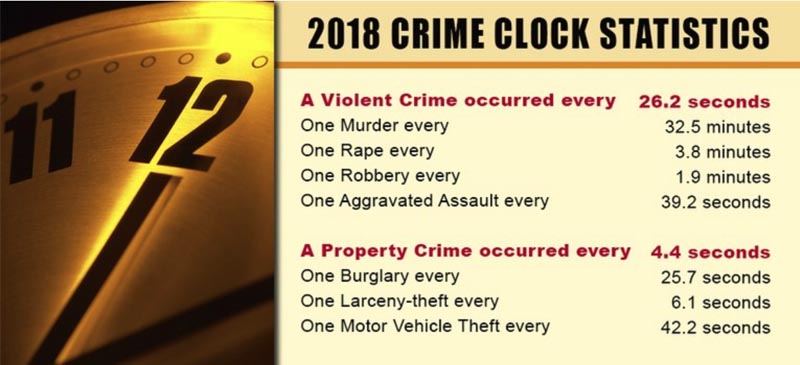
As promised, I want to end with the 3rd case study of a student who stood up and did something. I want to tie in the Reverend Dr. Martin Luther King Junior’s principles and the United Nations list of 16. I will below.
Case of Student #3:
Another student took a self-defense course for PE credit and learned better how to protect herself while reducing the danger for others. Another student (I’ll call her “Carol”) told her professor that the day before her own roommate had gone for a jog and did not return. She herself found her nearly dead and horribly beaten near their apartment complex. Carol and that professor told the rest of the students what had happened and that the victim was also a student at their college. Then they had an honest open classroom discussion about what they wanted to do. During the discussion one student said, “I want to do something.”
That led to discussions about how rape victims often blame themselves for the rest of their lives for the rape; that rape victims, define their life as “before the rape and after the rape;” and that even though as a class they were not able to prevent the rape, they would stand up and help that young rape victim know that she was not alone and that they stood with her. They planned a fund raiser, contacted the media, called for anyone who wanted to sign a petition to come do so. Their theme was three-fold:
First, they wanted to declare out loud to the rape victim and her family, to the campus community, and to the rest of society that “Rape is Wrong!” Second, they wanted to give the rape victim something she could also focus on and not spend the rest of her life around the attack, but remember that strangers, fellow students, and others stood with her so she did not have to stand alone. They printed T-shirts that read “WE Stand With You!” After hearing that the police had spent 23 hours after the rape, uniting multiple police agency efforts and apprehended the perpetrator within 1 day.
The third theme was that the rape victim would not attend one day of trial without students and other volunteers from the community picketing outside the courthouse in favor of his conviction. During the fundraiser a TV News reporter came and interviewed the professor and students. That led to a regional response and support started coming by mail, emails, telegrams, and phone calls. Over 3,000 people signed the petition. The perpetrator had DNA from the victim on his person and he had left DNA evidence at the crime scene. Evidence mounted so that they also planned to charge him with Attempted Murder or Attempted Manslaughter. He was a coward at his core and cut a plea deal to avoid trial and to avoid being placed in the general population of hard-core inmates (who violently abuse convicted sex offenders). He pled to attempted murder with no chance for parole and was sentenced to serve in “protective custody.”
From Cases 1, 2, and 3 in this chapter I can easily spot how 8 of the 16 UN Steps were taken by different students in the case of a sexual assault. I want to let you see which of the 8 (or perhaps more) steps you can identify and for the sake of this chapter focus only on UN Step number 14 “Be An Active Bystander.” The details are:
“…Intervening as an active bystander signals to the perpetrator that their behaviour is unacceptable and may help someone stay safe. First, assess the situation to determine what kind of help, if any, might be appropriate. You may be able to support the target of sexual harassment by asking how they are or if they would like help, or by documenting the incident, creating distractions to diffuse the situation, or making a short and clear statement directly to the perpetrator such as, “‘I’m uncomfortable with what you are doing.” (see UN (18 Nov. 2019) “16 ways you can stand against rape culture” retrieved 27 July 2020 from SOURCE).
I focus on Step 14 because you can make sure you remain safe and still actively change the outcome by helping to prevent a potential sexual assault, helping catch an alleged perpetrator while providing support to a victim, and or standing with the victim so they do not have to go through it alone. In all 3 cases you can also see how King’s “Nonviolence” principles made the difference. Nonviolence versions of getting involved take a bit of courage, but builds a stronger courage within the participants. Nonviolence focuses on the evil of rape (and racism) and not just on the people who rape. Nonviolence chooses love instead of hate.
Perhaps, love for others in our collective communities could benefit students and other members of campus communities. King taught that “love is spontaneous, unmotivated, unselfish, and creative.” (Quoted from “The King Philosophy Triple Evils”, Retrieved on 27 July 2020 from SOURCE). Finally Kingtaught about social change coming from our teaching others and taking a committed and direct action where and when we can.
Additional Reading
Search the keywords and names in your Internet browser
- Rape Abuse Incest National Network LINK
- Non-profit website that also sponsors the Healthy Masculinity Summit Men can Stop Rape LINK
- Full Report of the Prevalence, Incidence, and Consequences of Violence Against Women 2000 by Patricia Tjaden & Nancy Thoennes LINK
- -US Center for Disease Control’s Rape Prevention and Education (RPE) Program LINK
- -National Center for Victims of Crime LINK
- -BJS Report on US intimate Partner Violence 1993-2011 LINK
- -What happens when men get raped by other men? LINK
- -Nordic Country Rape Problem LINK